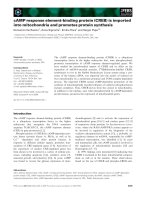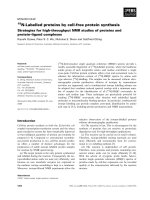Lecture presentation protein synthesis
Bạn đang xem bản rút gọn của tài liệu. Xem và tải ngay bản đầy đủ của tài liệu tại đây (1.2 MB, 20 trang )
Protein Synthesis
From: Protein Data Bank PDB ID: 1A3N
Tame, J., Vallone, B.: Deoxy Human Hemoglobin. 1998
Nucleic Acids
Nucleic acids made up of
chains of nucleotides
Nucleotides consist of:
A base
A sugar (ribose)
A phosphate
Two types of nucleic acids
in cells:
Deoxyribonucleic acid (DNA)
Ribonucleic acid (RNA)
Adapted from: Bettelheim FA and March J (1990)
Introduction to Organic and Biochemistry
(International Edition). Philadelphia: Saunders
College Publishing p383.
Nucleic Acids
Nucleic acids have
primary and
secondary structures
DNA
Double-stranded helix
H-bonds between
strands
RNA
3 kinds (mRNA, tRNA,
rRNA)
All single strands
H-bonds within strands
From: Bettelheim FA and March J (1990) Introduction to Organic and
Biochemistry (International Edition). Philadelphia: Saunders College
Publishing p391 (Left panel) and 393 (Right panel).
Complementarity of bases
The different bases in the
nucleotides which make up
DNA and RNA are:
Adenine
Guanine
Cytosine
Thymine (DNA only)
Uracil (RNA only)
Chemical structure only allows
bases to bind with specific
other bases due to chemical
structure
DNA
RNA
Adenine
Uracil**
Thymine*
Adenine
Guanine
Cytosine
Cytosine
Guanine
Table showing complementarity of base pairs
* Present only in DNA
**Present only in RNA
From: Elliott WH & Elliott DC. (1997) Biochemistry and Molecular Biology. New
York: Oxford University Press. P245.
DNA
DNA
Located in 23 pairs of
chromosomes in nucleus
of cell
DNA has two functions:
Replication reproduces itself when
cell divides
Information
transmission
– via protein synthesis
From: Tortora, GJ & Grabowski SR (2000) Principles of Anatomy
and Physiology (9th Ed). New York: John Wiley & Sons.
P86.
DNA
DNA contains genetic
information
Gene - segment of DNA
on a chromosome that
codes for a particular
protein
Coding contained in
sequence of bases (on
mRNA) which code for
a particular amino acid
(i.e. genetic code)
Genetic code universal
in all organisms
– Mitochondrial DNA
slightly different
From: Elliott WH & Elliott DC. (1997) Biochemistry and Molecular Biology. New
York: Oxford University Press. P294.
RNA
Four types of RNA:
Messenger RNA (mRNA) - carries genetic
information from DNA in nucleus to cytoplasm
where proteins synthesised
Transfer RNA (tRNA) - carries amino acids from
amino acid pool to mRNA
Ribosomal RNA (rRNA) - joins with ribosomal
proteins in ribosome where amino acids joined to
form protein primary structure.
Small nuclear RNA (snRNA) - associated with
proteins in nucleus to form small nuclear
ribonucleoprotein particles (snRNPs) which delete
introns from pre-mRNA
Information transmission
Information stored in DNA transferred to
RNA and then expressed in the structure of
proteins
Two steps in process:
Transcription - information transcribed from DNA
into mRNA
Translation - information in mRNA translated into
primary sequence of a protein
Transcription
Information transcribed from DNA into
RNA
mRNA carries information for protein
structure, but other RNA molecules formed
in same way
RNA polymerase binds to promoter
nucleotide sequence at point near gene to
be expressed
DNA helix unwinds
RNA nucleotides assemble along one DNA
strand (sense strand) in complementary
sequence to order of bases on DNA
beginning at start codon (AUG - methionine)
Transcription of DNA sense strand ends at
terminator nucleotide sequence
mRNA moves to ribosome
DNA helix rewinds
From: Tortora, GJ & Grabowski SR (2000) Principles of Anatomy and
Physiology (9th Ed). New York: John Wiley & Sons. P88.
Transcriptional control
Each cell nucleus contains all genes for that organism but genes
only expressed as needed
Transcription regulated by transcription factors
Proteins produced by their own genes
General transcription factors interact with RNA polymerase to
activate transcription of mRNA
If transcription factors promote transcription - activators
If transcription factors inhibit transcription - repressors
Numerous transcription factors required to initiate transcription
General transcription factors set base rate of transcription
Specific transcription factors interact with general transcription
factors to modulate rate of transcription
Some hormones also cause effects by modulating rate of gene
transcription
Regulation of transcription in skeletal muscle
Ca2+ initiates contraction
Cytoplasmic Ca2+ concentration
reflects frequency and duration of
fibre activation
Calcium binds to calmodulin (CaM)
Calcineurin dephosphorylates
transcription factor called nuclear
factor of activated T cells (NFAT)
Ca2+-CaM complex binds to
calcineurin (a protein phosphatase)
NFAT first identified in T cells, but also
found in skeletal muscle
NFAT binds to response element in
nucleus
Response element regulates gene
transcription
– Increases expression of genes for
myogenic regulatory factors
influence synthesis of myosin
light and heavy chains
From: Houston ME (2001) Biochemistry Primer for Exercise Science.
Champaign: Human Kinetics, p168.
Translation (protein synthesis)
Information in mRNA translated
into primary sequence of a protein
in 4 steps:
ACTIVATION
INITIATION
ELONGATION
TERMINATION
Translation (protein synthesis)
ACTIVATION
Each amino acid
activated by
reacting with ATP
tRNA synthetase
enzyme attaches
activated amino
acid to own
particular tRNA
Adapted from: Bettelheim FA and March J (1990) Introduction to Organic and
Biochemistry (International Edition). Philadelphia: Saunders College
Publishing p398
Translation (protein synthesis)
INITIATION
mRNA attaches to
smaller body of
ribosome
Initiator tRNA attaches
to start codon
Larger body of ribosome
combines with smaller
body
From: Tortora, GJ & Grabowski SR (2000) Principles of Anatomy and
Physiology (9th Ed). New York: John Wiley & Sons. P88.
Translation (protein synthesis)
ELONGATION
Anticodon of next tRNA binds to
mRNA codon at A site of
ribosome
Each tRNA specific for one amino
acid only, but some amino acids
coded for by up to 6 codons
– Order of bases in mRNA codons
determine which tRNA
anticodons will align and
therefore determines order of
amino acids in protein
Amino acid at A site linked to
previous amino acid
Ribosome moves along one
codon and next tRNA binds at A
site
From: Tortora, GJ & Grabowski SR (2000) Principles of Anatomy and
Physiology (9th Ed). New York: John Wiley & Sons. P88.
Translation (protein synthesis)
TERMINATION
Final codon on mRNA
contains termination
signal
Releasing factors cleave
polypeptide chain from
tRNA that carried final
amino acid
mRNA released from
ribosome and broken
down into nucleotides
From: Tortora, GJ & Grabowski SR (2000) Principles of Anatomy and
Physiology (9th Ed). New York: John Wiley & Sons. P88.
Control of protein synthesis
Rate of protein synthesis:
suppressed during exercise
increases for up to 48 hours post-exercise
Increased protein synthesis during post-exercise period
– unlikely to be due to increased transcription of RNA
Changes in protein synthesis independent of total RNA
– more likely due to change in translational control of mRNA
Recent evidence points to involvement of translational
initiation factors (eIF4E & eIF4G)
Extent of post-exercise protein synthesis also
dependent on half-life of mRNA
Controlled by ribonucleases (degradative enzymes)
Other proteins stabilise and destabilise mRNA against
degradation by ribonucleases
Mitochondrial protein synthesis
Mitochondria contain own DNA
and protein synthesizing
machinery
Mitochondrial genetic code
slightly different
Codon-anticodon interactions
simplified
Manage with only 22 species of
tRNA
Synthesise only small number of
proteins
Most mitochondrial proteins coded
for in nucleus and transported into
mitochondria
Adapted from: Tortora, GJ & Grabowski SR (2000) Principles of
Anatomy and Physiology (9th Ed). New York: John Wiley &
Sons. P84.
Protein degradation
Protein content of a cell depends on balance
between protein synthesis and degradation
Change in protein = synthesis rate - degradation rate
Protein degradation
Three main protein degrading systems in muscle:
Ubiquitin-proteosome
– Protein marked for degradation by attachment of ubiquitin units
– Inactive 20S proteosome activated by regulatory protein to
become active 26S proteosome
– 26S proteosome breaks protein into small peptides
Small peptides broken down into free amino acids by other
processes in cell
Lysosomal
– Proteins enter lysosome via endocytosis
cathepsins and proteinases degrade bonds
Calpain
– Calcium activated proteinase in cytosol of cell
Various isomers activated at different calcium
concentrations









